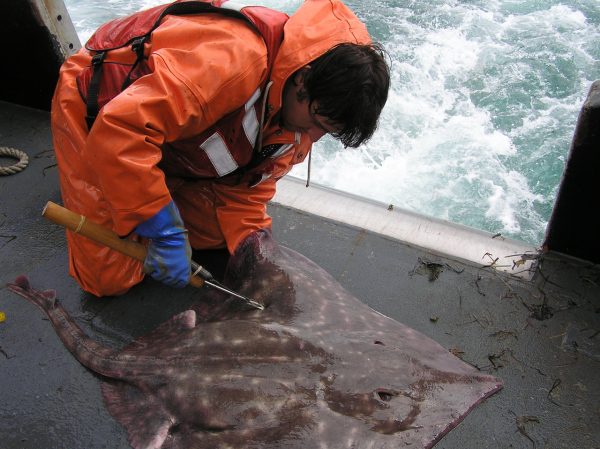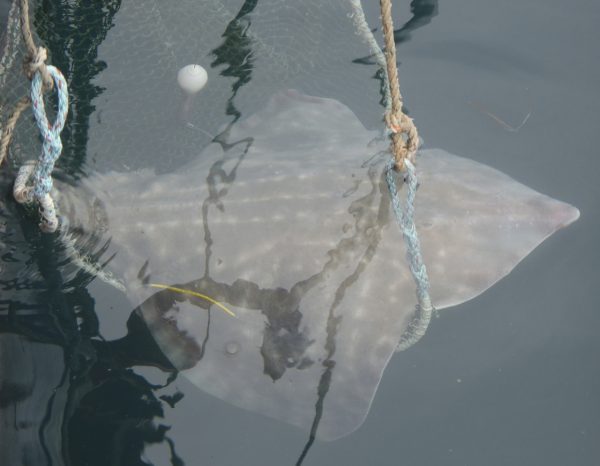Tagging study finds distance-swimming big skates
September 15, 2016
Lauren Frisch
907-474-5350
Big skates are capable of traveling thousands of kilometers, and many don’t have the
sedentary lives that were historically associated with the species, according to a
new study by University of Alaska Fairbanks researchers. Their study could help determine
whether a skate fishery in the Gulf of Alaska is feasible.
“Skates are flat, bottom-feeding fish,” said Thomas Farrugia, a doctoral student at
the UAF School of Fisheries and Ocean Sciences. “It was previously thought that they
sit in one spot and look for crabs, clams and little fish to eat but don’t have much
need to move a whole lot like an oceanic predator. But it turns out big skates can
move quite a long distance. One fish we studied completed a loop that was at least
2,100 kilometers.”

Farrugia is working with SFOS professor Andrew Seitz to determine whether there can be a sustainable and profitable fishery for big skates (Beringraja binoculata) in the Gulf of Alaska. Because little is known about such skates, the first step is to consider where they live and how far they tend to travel. As Farrugia explained, this will affect how the species is managed.
“We can’t start planning a directed skate fishery at the local scale, when in reality the big skates can travel a few thousand kilometers, possibly even more,” Farrugia said. “We need to consider the whole Gulf of Alaska big skate population as one stock, rather than a number of distinct subunits.”
Farrugia and Seitz monitored big skate movement using pop-up satellite archival transmitting tags. The satellite tags are a great way to gather basic information about a species for which there is limited data. Although each tag is expensive, fish don’t need to be recaptured once they are tagged. At a pre-programmed time, a fish’s tag will pop off and float to the surface, where it will transmit collected data to satellites that researchers can then access to download the data.
The researchers tagged eight big skates, and received data back from six of them. Half of the tagged skates swam hundreds of kilometers, but one one swam about 2,100 kilometers. Tagged fish were juveniles and mature adults, and all were greater than 100 centimeters in total length. This isn’t even close to the largest big skates, which can be about 2.5 meters long.
The researchers collaborated with the National Oceanic and Atmospheric Administration, which provided guidance on study design and ship time on the annual National Marine Fisheries Service Gulf of Alaska longline survey. The Alaska Department of Fish and Game participated by providing guidance and ship time on the multispecies bottom trawl survey.

For the next part of his dissertation, Farrugia will plug what he learned about big skate ecology and movement into a stock assessment model. Because he learned that skates can travel such great distances, he will create a model for the entire Gulf of Alaska. In the study's final step, he will create a bioeconomic model that evaluates whether a profitable fishery is sustainable.
Farrugia was part of the Marine Ecosystem Sustainability in the Arctic and Subarctic Program. He received additional support from Alaska Sea Grant, the Rasmuson Fisheries Research Center and the University of Alaska Fairbanks.
The researchers reported their findings in a Sept. 8 article in Marine Ecology Progress Series.


